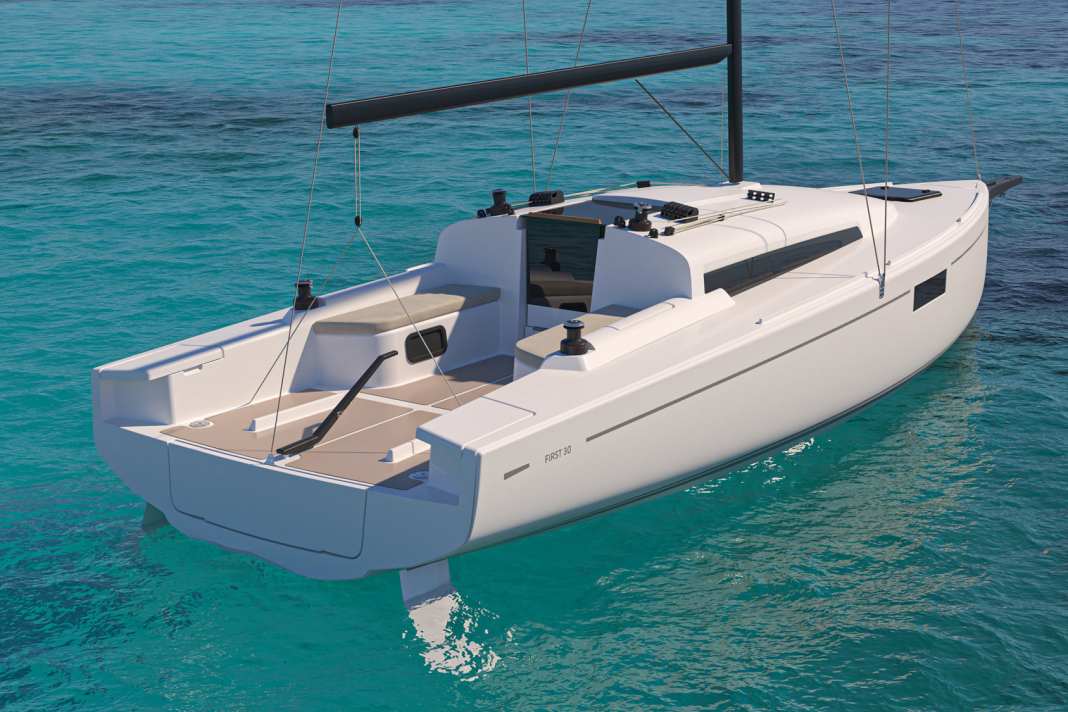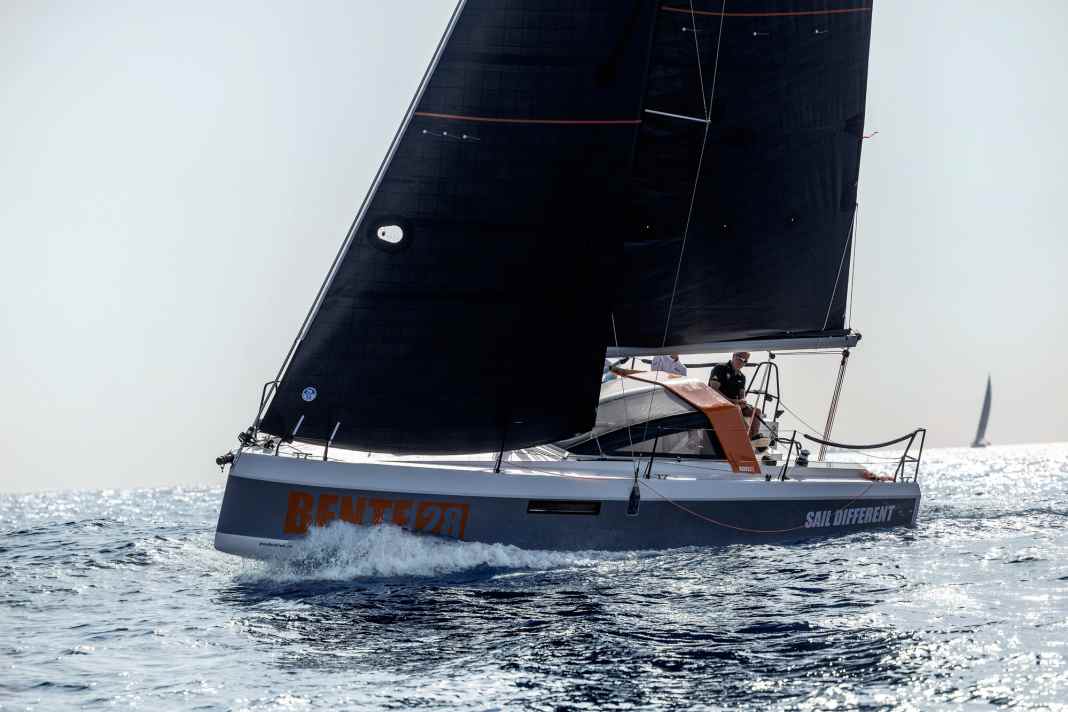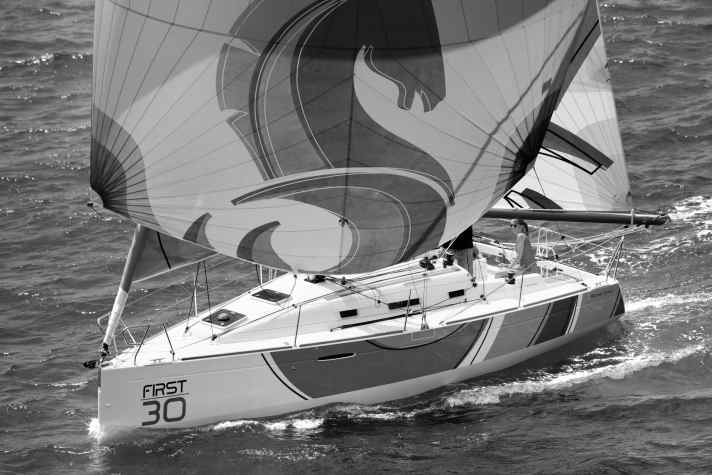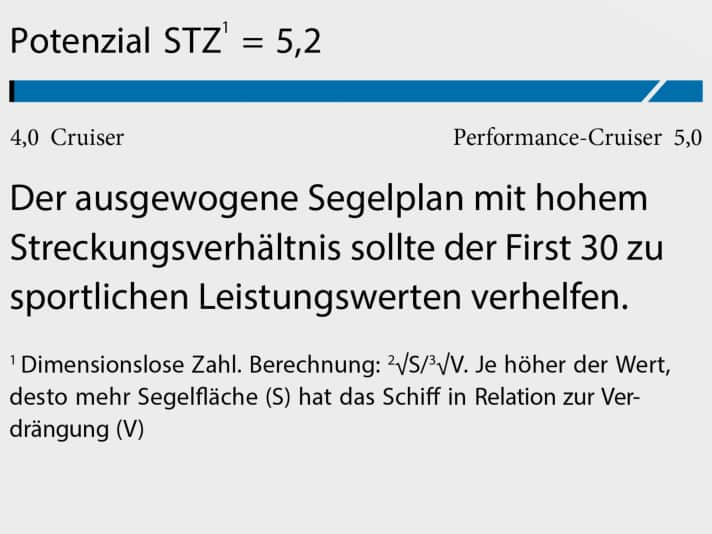





- First 30 causes a furore even before its premiere
- The competition of the First 30
- Gap between ridge 27 and 36 is closed
- Quite cosy despite the dominance of GRP surfaces
- Not a racer in disguise, but a "gliding cruiser"
- The pioneers of the new First 30
- The new First 30 in detail
- Equipment, prices and shipyard
The influence of a single person on the course of events, the course of a company and the success of a strategy is rarely as clear as with this boat. And even if it points to the future, it is worth rewinding just under 50 years. Because back then there was already a First 30, which from today's perspective was groundbreaking, if not pioneering. And then there was: Annette Roux.
She is the granddaughter of Benjamin Beneteau, the founder of the world's largest sports boat shipyard, number 358 of the 500 richest Frenchmen and women. In the mid-seventies, the then young company boss ventured a surprising expansion of the portfolio. On the initiative of François Chalain, she decided to develop a new series boat from the moulds of the 1974 World Championship winning half-tonner. It was a bet on the future. At the time, Beneteau's main source of income was fishing boats, and all of its designs had previously come from the company itself - until the project that changed everything in 1976.
Also interesting:
"Together with designer André Mauric, we changed the sail plan, reworked the keel, the interior fittings and the deck structure," recalls Annette Roux, who is still respectfully referred to as "Madame" by everyone at the shipyard. Because it was a new beginning, "we called the boat 'First'. Nobody expected that from us."
First 30 causes a furore even before its premiere
The sporty yacht developed from a standing start into a bestseller. In less than five years, more than 950 hulls were built. One year after its replacement, Beneteau was the world market leader. "We opened the doors to exports with her," says the now 82-year-old, who continues to help set the course of the shipyard as Chairwoman of the Beneteau Foundation.
And so it is no coincidence that Sales Director Yann Masselot announced a new First 30 in Cannes on 10 September. There could not be a more symbolic model to celebrate the brand's 140th anniversary - especially as it is Beneteau's only new development for 2024.
Although it was not on show at the Yachting Festival on the Côte d'Azur, as it will only make its trade fair debut in 3D at boot Düsseldorf 2025, it dominated the headlines right from the start. Firstly, because compact production yachts in the nine-metre class have become rare on the market and the First 30 is being offered at a comparatively low price at a time when prices are sky-high everywhere.
The competition of the First 30




Secondly, because, like her ancestor, she is intended to revitalise and even shape an entire segment: that of "fast, uncomplicated, gliding cruising yachts", as Yann Masselot emphasised at the launch.
Gap between ridge 27 and 36 is closed
The concept was developed in a joint venture between Beneteau and Seascape. The Slovenian shipyard is responsible for all First models from 40 feet downwards within the Group and has earned a first-class reputation, having won three European Yacht of the Year titles to date.
The First 30 closes a large gap in the previous range, which existed between the First 27 and 36. As with all Seascape designs, the construction is by Sam Manuard, one of the most successful architects for ocean-going racing yachts. Lorenzo Argento, brought in by Beneteau, was responsible as stylist. The laminate plan and structure were calculated by Giovanni Belgrano's Pure Design & Engineering. A team that vouches for sailing efficiency and visual aesthetics and has already left its mark on the First 36.
The new model is very similar in shape and proportions. However, unlike its bigger sister, the margins for the First 30 were considerably smaller and the scope for development was therefore much tighter. Above all, the goal of not breaking the 100,000 euro mark in net price presented Seascape CEO Andraz Mihelin's team with considerable challenges.
As weight is also a critical factor in enabling early planing, it became an exercise in intelligent omission - but without neglecting basic comfort requirements. In fact, the First offers everything you need for cruising: two bedrooms, kitchen, bathroom and sea terrace. The double berth in the bow is generous for a sporty boat of this size and reaches queen-size format in the shoulder area; only aft is it tight for two adults.
Quite cosy despite the dominance of GRP surfaces
As usual with Seascape, the furniture foundations are part of the load-bearing structure and, just like the hull and deck, are laminated from a lightweight GRP sandwich. As standard, there is only one folding door that closes with magnets - the one to the wet room, which is also made of lightweight foam panels.
There are no floorboards in front of the companionway; these can only be found in the slightly raised saloon. Instead, the hull floor is covered with a 6-millimetre-thick Seacork covering, which can also be laid in the cockpit as an option and for an extra charge. This leaves enough headroom of 1.85 metres where it counts most below deck. Above all, however, all these measures save weight, which is why the First 30 displaces a good half tonne less than its smaller predecessor from 2011, which was still built entirely in plywood. These are worlds apart, and this is also reflected in the higher sail carrying capacity of the current model (5.2 vs. 4.9).
Despite the dominance of GRP surfaces, the computer illustrations make the First 30 look quite cosy. And this is probably also true to the character, if you look at the design of the 36. However, its detailing will not be as comprehensive.
The colour-contrasting textile panels on the hull walls, for example, are an optional extra; as in the cabins, only the "woodchip look" of uncovered laminate coated only with acrylic varnish is available as standard. However, you can make the interior more cosy. In addition to the wall panelling, the options list includes a hot water boiler and heating. Magnetic doors for the cabins and matching storage bags can also be ordered.
Another desirable feature would be a hatch in the forward part of the cabin superstructure to improve ventilation and enable gennakers or Code Zero to be stowed in the saloon. So far, this has not even been included as an extra. Instead, the shipyard offers solar panels that are mounted in front of the mast and refers to the 60 cm hatch in the foredeck. At least there are side windows in the wet room and above the galley for cross ventilation as standard.
Not a racer in disguise, but a "gliding cruiser"
Remarkable: The First has plenty of storage space on deck. At the very stern, two forecastle boxes hold a gas bottle, mooring lines and small items. More than two cubic metres are available for storing fenders, sails and other equipment under the starboard cockpit, accessible via a large hatch, which is more than usual in this class.
In contrast to the shipyard renderings, the boat will of course be delivered with a CE-compliant sea railing. According to the preliminary classification, the First 30 is certified for category A (high seas) with a crew of up to two people - an important aspect for authorisation for demanding sea races. Category B applies for a crew of up to six.
Nevertheless, the new Beneteau should not be misunderstood as a racer in disguise, although it will certainly be well represented at Silverrudder, Baltic 500 or MidsummerSail. At its core, it is a boat designed to provide sailing fun for the widest possible target group.
Seascape founder Andraz Mihelin sees the First 30 as part of a tradition with the original from the year 76, which also established a market that didn't really exist yet. This is why the visionary, who already proved with the Seascape 18 that he likes to think outside the box, has created a separate category for the nine-metre speedster: instead of a performance cruiser, he prefers to call it a "planning cruiser", which literally translates as "gliding cruiser".
It's a big promise: even at 3 to 4 Beaufort, the First 30 should effortlessly detach itself from its own wave system and sail in double figures. A year later, he wants to take it to another performance level with a "Seascape Edition" that will be even lighter and more powerful - just like the First 36 SE that was also announced in Cannes. The only question is whether he will run out of places to build it. Even before the presentation, Beneteau dealers had already blind pre-ordered and paid for 50 boats. Deliveries will start in February. It is therefore quite possible that the success story of the first First 30 is about to repeat itself.
The pioneers of the new First 30
First 30 - The trailblazer

The first model is created from the moulds of the "L'Impensable", winner of the Half Ton Cup. The keel, sail plan, fittings and superstructure are adapted. She is the star at her premiere at the Paris Yacht Show. The First 30 becomes the boat for the Tour de France à la Voile and the Course de l'Aurore. Second-hand price: 8,000 to 15,000 euros.
- Sales period: 1976-1981
- Production figure: 824
- Torso length: 8,95 m
- Waterline length: 7,75 m
- Width: 2,86 m
- Draught/alternative: 1,70 m
- Weight: 3,45 t
First 31.7 - The blockbuster

The boat designed by Jean-Marie Finot is considered the benchmark in terms of the commercial success of the series. The hull was not only used for the 31.7, but also for the first Figaro, the First 310 and even for the Oceanis 300 and 311. The all-rounder is still in demand today as a second-hand boat; well-preserved examples cost around 50,000 euros.
- Sales period: 1997-2010
- Production figure: 1179
- Torso length: 9,61 m
- Waterline length: 8,80 m
- Width: 3,23 m
- Draught/alternative: 1,90 m
- Weight: 3,75 t
First 30 - The promise

Developed by star designer Juan Kouyoumdjian and Vendée winner Michel Desjoyeaux, the last First 30 promised a lot. However, it suffered from the heavy construction; it also failed to achieve any major regatta successes. Its failure called the entire model series into question. However, it is still popular as a fast cruising boat. Current price: 60-70,000 euros.
- Sales period: 2011-2015
- Production figure: 141
- Torso length: 9,52 m
- Waterline length: 8,39 m
- Width: 3,20 m
- Draught/alternative: 1,90/1,50 m
- Weight: 3,75 t
The new First 30 in detail

Technical data of the First 30
- CE design category: A2/B6
- Torso length: 9,35 m
- Total length: 10,33 m
- Waterline length: 8,75 m
- Width: 2,95 m
- Depth: 1,98 m
- Mast height above WL: 14,70 m
- Theor. torso speed: 7.2 kn
- Weight: 3,15 t
- Ballast/proportion: 1,07 t/34 %
- Mainsail: 29,8 m2
- Furling genoa (106 %): 28,2 m2
- machine (Yanmar 2YM15): 10 kW/14 hp
- Fuel tank: 50 l
- Fresh water tank: 120 l
- Holding tank: 50

Hull and deck construction
GRP sandwich construction, vacuum-infusion laminated with vinyl ester resin. GRP interior as part of the hull structure, also vacuum-infused. Cast iron keel with T-shaped bomb
Cockpit layout
In addition to the mainsheet guide via a cockpit and German sheeting, a traveller with a double jib for coarse and fine trim is also available on request
Alternative drive
As an option, Beneteau also offers the First 30 with an electric 6 kW pod motor from Torqeedo instead of a Yanmar diesel engine
Equipment, prices and shipyard
- Base price ex shipyard: 119.000 €
- Approx. price ready to sail: 140.000 €
- Warranty/g. Structural damage: 3/10 years
Shipyard
Seascape d.o.o., Podpec 53, 1352 Preserje, Slovenia. www.beneteau.com/de

